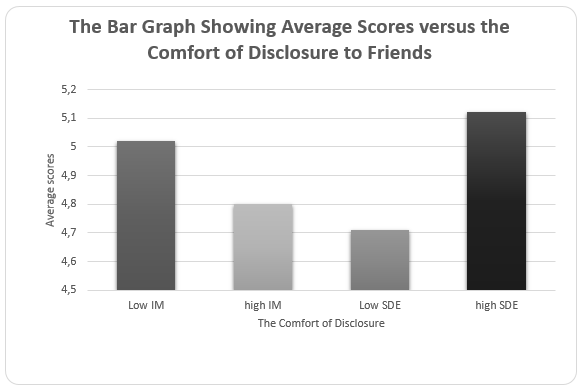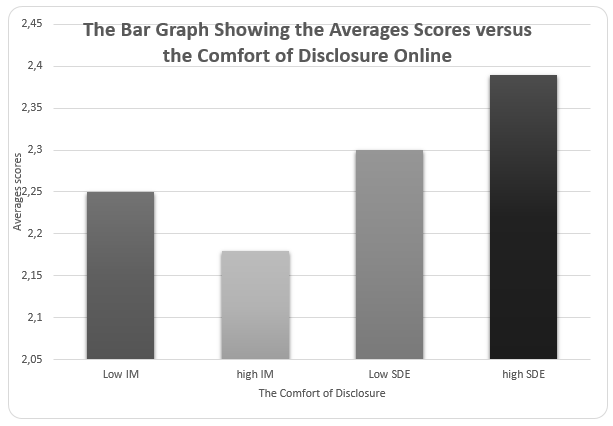Methodology
Participants
The participants of the study are online users from various parts of the world, who could access the course website and fill surveys provided. The study selected 164 participants, who were able to answer the provided surveys appropriately. Out of 164 participants, 128 were females, while 36 were males. The gender analysis of participants shows that female participants were more than triple the number of male participants. Descriptive statistics indicate that the mean age of female participants (M = 30.86, SD = 11.59) was slightly higher than the mean age of male participants (M = 29.03, SD = 11.91). Moreover, the descriptive statistics show that the participants of the study were young adults, who have their ages ranging from about 40 years and 19 years basing on the standard deviation and the mean.
Materials
The study used online surveys in collecting data from the participants of the study regarding the social desirability and comfort of the disclosure. Social desirability comprises of two major elements, namely, self-deception enhancement (SDE) and impression management (IM). According to Paulhus (1984), SDE and IM are two parameters that effectively measure the social desirability of responses that people make.
In this view, the online surveys had social desirability as an independent variable, which influences the comfort of disclosure among participants. Close friends and social site users also comprise the independent variables of the study, which influence the comfort of disclosure among participants. In assessing the comfort of disclosure, the survey used a 7-point scale, which ranges from the very uncomfortable (1) to the very comfortable (7).
The comfort of disclosure is the dependent variable in which the study used in assessing participants basing on the identified items. The three items assessed the comfort of disclosing the ability to loan money to a best friend, revealing shoplifting behavior, and being unable to bear children owing to medical reasons.
Design and Procedure
The study employed a survey as the design of data collection among the participants. The procedure of data collection occurred through the online surveys in which the participants filled on the course website. The participants provided their demographic details before undertaking an assessment of the comfort of the disclosure. The participants provide their age, state whether they are close friends or social site users, identified their social desirability of responses in terms of SDE and IM, and indicated their comfort with the disclosure. The study then analyzed the collected data and presented the findings in tables and figures.
Results
Disclosure to Friends
As a function of socially desirable responding, the mean comfort of disclosure to best friends in terms of IM and SDE is relatively high on a scale of 1 to 7. In response to the statement of loaning money to a friend, the low IM is 5.11 and the high IM is 5.25. Likewise, the statement of loaning money to a friend has a low SDE of 4.77 and a high SDE of 5.66. In the aspect of disclosing shoplifted, the mean comfort of disclosure in terms of low IM and high IM is 4.95 and 4.06 respectively. Moreover, the mean disclosure of shoplifted is 4.64 and 4.36 for low SDE and high SDE respectively. The inability to bear children due to medical reasons scored a low IM of 3.47 and high IM of 2.65, while low SDE is 2.72 and high SDE is 3.32.
Table 1.
The figure below indicates the distributions of averages scores among low IM, high IM, low SDE, and high SDE. The figure shows that the averages scores of IM and SDE range from 4.71 to 5.12, which are not significantly different.

Online Disclosure
As a function of socially desirable responding, the mean comfort of disclosure online via social sites such as Facebook and Twitter in terms of IM and SDE depicts low figures. The mean comfort of disclosure of loaning money indicates that 2.33 and 2.16 are low IM and high IM respectively, while 2.28 and 2.22 are low SDE and high SDE respectively. Regarding the scores of shoplifted, 1.86 and 1.73 are low IM and high IM respectively, whereas 2.00 and 1.63 are low SDE and high SDE correspondingly. The comfort of disclosing the inability to bear children due to medical reasons shows that the degree of comfort in terms of IM is 3.47 for low and 2.65 for high. Moreover, SDE indicates that 2.72 and 2.32 are scores for low SDE and high SDE respectively.
Table 2.
The figure below depicts the distribution of average scores of IM and SDE components of social desirability. From the figure, it is evident that SDE has higher scores than IM.

Discussion
Regarding the comfort of disclosure, the study hypothesized that individuals with low IM are more comfortable when disclosing their private information to friends than those with high IM. In the statement of loaning money to a friend, the participants with low IM are less comfortable (5.11) than participants with high IM (5.25). Likewise, the participants with low IM are less comfortable in reporting their inability to bear children than the participants with high IM.
Contrastingly, in the aspect of shoplifting, the participants with low IM scored 4.95, which is higher than that of the participants with high IM having a score of 4.06. Overall, the average scores indicate that participants with low IM are more comfortable in disclosing their private information (5.02) than the participants with high IM (4.80). Hence, the findings confirm the hypothesis that individuals with Low IM are more comfortable when disclosing their private information to friends than those with high IM.
The comfort of disclosure varies from one person to another, depending on numerous social forces. According to Omarzu (2000), the comfort of disclosure is subject to identity development, relationship development, social control, social approval, and stress relief. These social factors are very influential in determining the comfort of disclosure among individuals. In this case, the participants with low IM are more comfortable in disclosing their private information to friends because of the social support and approval that they get from friends. Drory and Zaidman (2007) argue that social support and social approval make individuals disclose their private information comfortable to superiors or close friends.
Regarding SDE, the study hypothesized that individuals with low SDE are less comfortable in disclosing their private information to friends than those with high SDE. The SDE scores indicate that the participants with low SDE are less comfortable in disclosing their ability to loan money than the participants with high SDE. Similarly, the participants with low SDE are less comfortable to disclose their inability to bear children than those with high SDE.
In disclosing the information about the experience of shoplifted, the participants with low SDE are more comfortable than the ones with high SDE. The average scores show that the participants with low SDE scored 4.71, while those with high SDE scored 5.12. The average scores, therefore, support the hypothesis that individuals with low SDE are less comfortable in disclosing their private information to friends than those with high SDE.
self-deceptive enhancement influences the way people present their image depending on the nature of the target audience. Paulhus (1984) asserts that individuals tend to enhance their image among close friends because they want to comply with social norms and traditions. In the findings, the participants with low SDE are less comfortable in disclosing their private information than the participants with high SDE. Such a trend indicates that people require high SDE so that they can disclose their private information to friends. Otter and Egan (2007) state that self-deceptive enhancement protects individuals from antisocial thinking. This statement explains why individuals with high SDE are more comfortable in disclosing their private information to friends than individuals with low SDE.
In the aspect of online exposure, the study hypothesized that individuals with low IM are more comfortable in disclosing their private information online than those with high IM. The findings show that the participants with low IM scored 2.55, which is higher than the score of 2.18 for the participants with high IM. Hence, these findings support the hypothesis that individuals with low IM are more comfortable in disclosing their private information via social media platforms such as Twitter, Instagram, and Facebook.
Lai and Yang (2014) hold that self-disclosure is dependent on the nature of the target audience. In this case, since the target audiences are social site users, their physical distance significantly influences the comfort of the disclosure. Forest and Wood (2012) argue that individuals with low self-esteem can comfortably disclose their private information online because of the physical distance of the audience.
The findings of the study confirm the hypothesis that individuals with low SDE are less comfortable in disclosing their private information online than those with high SDE. The participants with low SDE scored 2.3 while those with high SDE are 2.39. Comparison of these scores indicates SDE influences the comfort of disclosure among participants. Tufekci (2008) asserts that the target audience influences the comfort of disclosure because people tend to have enhanced comfort of disclosure online when compare to the physical disclosure to friends. Hence, individuals with high SDE are comfortable disclosing their private information online.
Knoll and Bronstein (2013) state that individuals with high SDE are comfortable in disclosing their private information because they can easily influence the impressions that they create among the audience. Since the disclosure occurs online, individuals with SDE have enhanced comfort as the findings present. Therefore, the findings reveal that the nature of the target audience, mode of disclosure, the level of IM, and degree of SDE influence the comfort of disclosing information among individuals.
References
Drory, A., & Zaidman, N. (2007). Impression management behavior: effects of the organizational system. Journal of Managerial Psychology, 22(3), 290-308. Web.
Forest, A.L., & Wood, J.V. (2012). When social networking is not working: individuals with low self-esteem recognize but do not reap the benefits of self-disclosure on Facebook. Ontario, Canada: Psychological Science, 23(3), 295-302. Web.
Knoll, M., & Bronstein, J. (2013). An examination of the information disclosure behavior of infertility bloggers. Journal of Information Management, 66 (2), 175-201. Web.
Lai, C., & Yang, H. (2014). Determinants of individuals’ self-disclosure and instant information sharing behavior in micro-blogging. New Media & Society, 16(5), 1-19. Web.
Omarzu, J. (2000). A disclosure decision model: determining how and when individuals will self-disclose. Personality and Social Psychology Review, 4(2), 174-185. Web.
Otter, Z., & Egan, V. (2007). The evolutionary role of self-deceptive enhancement as a protective factor against antisocial cognitions. Personality and Individual Differences, 43(8), 2258-2259. Web.
Paulhus, D.L. (1984). Two-component models of socially desirable responding. Journal of Personality and Social Psychology, 46 (3), 598-609. Web.
Tufekci, Z. (2008). Can you see me now? Audience and disclosure regulation in online social network sites. Bulletin of Science, Technology & Society, 28(1), 20-36. Web.